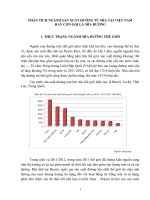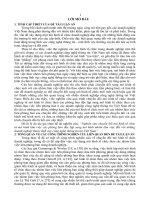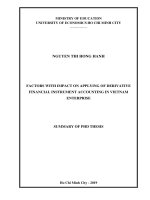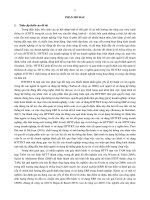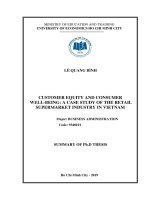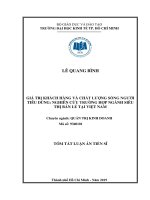Hạn chế tình trạng đô la hóa tại việt nam tt tiếng anh
Bạn đang xem bản rút gọn của tài liệu. Xem và tải ngay bản đầy đủ của tài liệu tại đây (911.24 KB, 35 trang )
MINISTRY OF EDUCATION AND TRAINING
STATE BANK OF VIETNAM
BANKING UNIVERSITY OF HO CHI MINH CITY
---------oo0oo---------
PHD. STUDENT: NGUYEN THI THU HIEU
LIMITING THE DOLLARIZATION STATUS
IN VIETNAM
SUMMARY OF DOCTORAL DISSERTATION IN ECONOMICS
HO CHI MINH CITY – 2019
MINISTRY OF EDUCATION AND TRAINING
STATE BANK OF VIETNAM
BANKING UNIVERSITY OF HO CHI MINH CITY
---------oo0oo---------
PHD. STUDENT: NGUYEN THI THU HIEU
LIMITING THE DOLLARIZATION STATUS
IN VIETNAM
SUMMARY OF DOCTORAL DISSERTATION IN ECONOMICS
MAJOR: FINANCE - BANKING
CODE: 9.34.02.01
SUPERVISOR: PROF. PHD. NGUYEN THANH TUYEN
HO CHI MINH CITY – 2019
-1-
CHAPTER 1
LITERATURE REVIEW
1.1. THE NECESSITY OF THE STUDY
With the process of strong economic integration, the transitional economies
have attracted a large amount of foreign currency through different channels. These
foreign currencies are important resources in helping countries in transition process to
promote economic development. However, these countries have been facing the
phenomenon of dollarization in the economy. Dollarization is often seen as an
indispensable product, an objective entity linked with the operating mechanism of an
open economic system, so the content of this phenomenon itself has shown its
positivity. However, when an economy is dollarized, the process of regulating money
supply of the central bank is difficult, as well as seriously affects the balance of the
foreign exchange market. Besides, when the contents of dollarization are abused by
subjective and spontaneous elements of members of society, or when the economic
management agencies do not have effective measures to control its negative sides,
dollarization will lead to unpredictable consequences for the economy - society.
In the same situation like most other developing countries, Vietnam has had a
long history of using the US dollar in parallel with the Vietnamese currency since the
1960s. After the reunification of Vietnam in 1975, Vietnam’s economy experienced a
long period of difficulties and failures in the price-wage-money policy of the domestic
currency, from which the public lost faith in the value of VND, the trend of gold and
foreign currencies increases, which made the phenomenon of dollarization become
more complicated. Although there have existed a great number of studies on
dollarization in the world as well as in Vietnam. However, the reality shows that the
dollarization status is still quite complicated, affecting the economic stability and
growth in the process of integration. Especially, there are still no effective ways to deal
with this phenomenon in the Vietnamese economy. Therefore, the author chooses the
-2-
topic: “Limiting the dollarization status in Vietnam” as a research topic for her
doctoral thesis.
1.2. REVIEW OF RELATED STUDIES
In the ability of approaching materials of the author, the researches on
dollarization in Vietnam mention the process of dollarization in Vietnam in terms of
causes, impacts and solutions in specific periods. However, there are still scientific
gaps as follows: (1) Regarding the research objectives, there have existed no studies
on the correlation between the dollarization status and macroeconomic indicators such
as: inflation, exchange rates, interest rates, foreign exchange reserves, ...; (2)
Regarding the scope of the study, there have been no studies on the comprehensive
evaluation of impact of dollarization phenomenon on the economy before, during and
after Vietnam’s accession to WTO according to the following criteria: deposit
dollarization, loan dollarization, cash dollarization, dollarization of valuation and
prices; (3) Regarding the research method, there have been no studies examining the
correlation between the phenomenon of dollarization and the macroeconomic
indicators in short-term as well as long-term.
1.3. OBJECTIVES AND RESEARCH QUESTIONS
Objectives: the thesis is conducted to obtain one main aim and three specific
objectives. The main aim is: to examine the dollarization status of the Vietnamese
economy, to determine the correlation between the dollarization status and the
macroeconomic indicators, thereby suggest some policies to limit the dollarization
status in Vietnam. Specific objectives are: (1) to analyze the dollarization status, to
identify the causes and impacts of dollarization on the economy from 1992-2017; (2)
to Identify the correlation between the dollarization status and the macroeconomic
indicators such as: economic growth, foreign exchange reserves, exchange rates,
inflation, interest rates,...; (3) to propose solutions to limit the dollarization status in
the Vietnamese economy.
Research questions to achieve the objectives: (1) How does the dollarization
phenomenon in Vietnamese happen through stages? What causes this phenomenon?
-3-
How does it affect Vietnam's economy? What measures have been used by the
Government to deal with the dollarization status? (2) Is there a correlation between the
dollarization status and the macroeconomic indicators such as inflation, exchange
rates, interest rates, foreign exchange reserves, ...? If yes, what is the direction and
degree of impact? (3) What are measures to limit dollarization status of the
Vietnamese economy in the background of integration?
1.4. THE SUBJECTS AND SCOPE OF THE STUDY
- Research subjects: the dollarization status, its causes, the relationship between
the dollarization status and the macroeconomic indicators. The dollarization status is
evaluated based on criteria: deposit dollarization, loan dollarization, cash dollarization,
dollarization of valuation and pricing. Among them, the study focuses on the deposit
dollarization and the loan dollarization. The macroeconomic indicators include:
inflation, exchange rate, interest rate, GDP growth, foreign exchange reserves and
import and export value.
- Scope of research: Regarding space, Foreign currency deposits and foreign
currency loans on the total deposits and loans of individuals and businesses in the
commercial banking system in Vietnam; In terms of time: the study examines the
period from 1992 to 2017.
1.5. RESEARCH METHODOLOGY
The study uses a systematic approach and dialectical materialism method, with
the use of descriptive statistical methods, synthetic analysis method combined with
comparative and interpretative methods to explain for the research problems used
throughout the thesis.
In addition, the thesis uses the method of quantitative regression with the
Vector Error Correlation Model (VECM), processed through Eviews 8.0 software to
solve the research question 2.
-4-
1.6. RESEARCH DIAGRAM
Resesarch problems
Resesarch objectives
Reseach methodology
Qualitative method
Quantitative method
• Current situation of dollarization
• Causes of dollarization
• Solutions to resolve dollarization
implemented by the Government
• The relationship between the status
of deposit dollarization and monetary
indicators
• The relationship between the status
of loan dollarization, economic
growth and export
Summaries
Findings
General conclusions
Solutions and Requests
1.7. CONTRIBUTIONS OF THE STUDY
Firstly, on the basis of systematizing general theories on dollarization, the
thesis evaluates comprehensively on the dollarization status in the Vietnamese
economy since its opening until now (from 1992 to 2017). The thesis also identifies
the causes of dollarization, analyzes and evaluates successes and limitations of
measures to overcome the dollarization status implemented by the Government during
the study period.
Secondly, in the research period, the dissertation has provided empirical
evidence on the relationship between the phenomenon of deposit dollarization and
some macro variables under the impact of the deposit rate ceiling policy. Research
results show: (1) Foreign exchange reserves and deposit interest rates of domestic
currency have a negative impact on the situation of deposit dollarization; (2) Parallel
market profits, foreign currency deposit rates, exchange rates and inflation have a
-5-
positive impact on the deposit dollarization status; (3) The policy of mobilizing twoceiling interest rates with USD deposit rate of 0% brings a good result, helps reduce
the deposit dollarization in stable macroeconomic conditions.
Thirdly, in the research period, the thesis examines the relationship between the
status of loan dollarization and economic growth and exports. Results show that the
status of loan dollarization has a negative impact on the economic growth; a positive
impact on exports in the short term; and a positive impact on the dollarization status
and the differential in costs paid when borrowing VND compared with USD.
1.8. ORGANIZATION THE STUDY
The study consists of 5 chapters:
Chapter 1: The literature review
Chapter 2: Theoretical background of dollarization
Chapter 3: The dollarization status in Vietnam in the period from 1992 to 2017
Chapter 4: Empirical evidence of the relationship between dollarization and
macroeconomic indicators
Chapter 5: Conclusions and solutions to limit dollarization in Vietnam
CHAPTER 2
THEORETICAL BACKGROUND OF DOLLARIZATION
2.1. DOLLARIZATION IN ECONOMY
2.1.1. General theories on dollarization and the dollarization status
2.1.1.1. Dollarization
❖ Definition: dollarization is a phenomenon of a currency of any countries in the
world appearing in the economy of another country in any forms, regardless the
acceptance or disapproval of the Government of that country. In other words,
dollarization is the phenomenon of people using money not issued by the Government
of that country.
❖ Classification: Based on the legality of foreign currency including official
dollarization, unofficial dollarization and semi-official dollarization; Based on the
-6-
monetary functions including dollarization replacing assets, dollarization replacing
payment also known as the currency dollarization, dollarization of listed valuation,
financial dollarization; Based on the mechanism of foreign currency occurrence
including deposit dollarization, loan dollarization, cash dollarization and dollarization
listed evaluation.
2.1.1.2. The dollarization status in economy
The phenomenon of dollarization in economy reflects the rates of use of foreign
currency to do monetary functions regardless the Government’s acceptance or
disapproval. Based on the classification criteria, dollarization is often quantified
according to different criteria. Two commonly used criteria (according to IMF):
Deposit dollarizations: DDI =
FCD
TD
(FCD: Foreign currency deposits, TD:
total deposit)
Loan dollarization:
LDI =
FCL
TL
(FCL: Foreign currency loans, TL: Total loan)
From the calculation results, dollarization will be assessed according to 3
levels: high (> 30%), average (from 10% to below 30%) and low (<10%).
2.1.2. The impact of dollarization on the economy
Dollarization has both positive and negative influences. Positive impacts: reduce
transaction costs and eliminate exchange rate risks; promote international trade and
world economic integration; reduce hyperinflation, help the economy overcome the
crisis. Negative impacts: reduce the effectiveness of the management of monetary
policy; limit the function of the central bank as the final lender; narrow the export
market share; easily lead to the risk of financial crisis; loose the control of the currency,
affect the nation’s political prestige; easily cause the instability in macroeconomic and a
series of other social issues.
-7-
2.1.3. The relationship between dollarization and macroeconomic indicators
2.1.3.1. Theory of currency choice
❖ Gresham Law: “bad money drives out good”. If the foreign currency is a
reliable and internationally accepted currency, it will be stored more than the domestic
currency.
❖ Theory of asset demand
According to Friedman (1956) and Mishkin (2003), to determine the need for
an asset, it is necessary to compare the benefits of holding that asset with those of
holding other assets. In an economy, if holding domestic currency has less benefit and
more risks than holding foreign currency, the demand for foreign currency will be
higher.
❖
Equal relations in the international financial market
• Equivalence of interest: including 2 types: Covered Interest Parity (CIP) and
Uncovered Interest Parity (UIP).
CIP has the form as: (1 + r) =
F
(1 + r*)
E
or CIP has the approximate form as: r − r* =
F−E
E
UIP has the form as: r − r* = E
• International Fisher effect: the combination of Fisher, the law of uncovered
interest parity (UIP) and the law of purchasing power parity (PPP):
According to Fisher: r = r e + pe
According to UIP:
E = r − r *
(1)
(2)
According to PPP: E = pe − p*e (3)
International Fisher effect: r e = r*e (combine (1), (2) and (3)
In which: r, r* is the nominal interest rate of the local and foreign currency; re,
r*e is the expected interest rate of the local and foreign currency; E, F are forward
exchange rate, spot exchange rates; ∆E is the expected fluctuation of the exchange
rate; pe, p*e is predicted inflation of the domestic and foreign currency.
-8-
In perfect market conditions, the interest rates of currencies tend to balance
with the fluctuation of exchange rates. In fact, investors tend to choose currencies with
higher convertibility and lower risks.
2.1.3.2. Correlation between dollarization and macroeconomic indicators
❖ Correlation between deposit dollarization and macroeconomic indicators
• Deposit dollarization and inflation
Inflation ↑
purchasing power of local currency ↓
Unofficial dollarization
Foreign currency demand ↑
Local currency demand ↓
Gresham,
Friedman,
Miskhin,
Fisher
Foreign currency price ↑
Local currency price ↓
Foreign demand for
domestic goods ↑
Cost of imported
goods ↑
↑
Official dollarization
→ currency exchange
Foreign currencies
perform currency
functions for local
currency
Inflation ↓
Prices of domestic goods↑
(Inflation↑)
Source: The author
• Deposit dollarization and exchange rate
Deposit dollarization increases when the expected exchange rate rises (∆E>0)
because holding foreign currency will be more beneficial than the domestic currency (
r r * +E ) and vice versa.
• Deposit dollarizations and interest rates
If foreign currency interest rate is higher than that of domestic currency, deposit
dollarization increases (r*e>re). Conversely, deposit dollarization decreases, re > r*e.
-9-
Deposit dollarization is positively related to the foreign currency and negatively
related to the domestic currency interest.
• Deposit dollarization and exchange rate differential between free market and
formal market (parallel market returns)
Countries that do not meet the demand for foreign currencies will tend to trade
on free markets, leading to higher price of foreign currencies in free market than that
in official market, stimulating the motive to hold foreign currencies to speculate.
Therefore, the higher the parallel market profit is, the more deposit dollarization
increases.
❖ Correlation between loan dollarization and macroeconomic indicators
• Loan dollarization and inflation
In theory, when high inflation occurs, borrowers will choose the domestic
currency because the real interest rate which must be paid is lower. This means loan
dollarization will decrease. In reality, when inflation is high, tight monetary policy is
applied, nominal interest rate of domestic currency is increased, so borrowers will
have more benefit when choosing foreign currency.
• Loan dollarization and exchange rates
When it is due, foreign currency borrowers have to pay the cost of r*+∆E while
domestic currency borrowers only have to pay the cost of r. Therefore, if the exchange
rate fluctuates constantly, foreign currency borrowers will face risks and vice versa.
The relationship between loan dollarization and exchange rate is a negative
relationship.
• Loan dollarization and interest rates
In theory, countries with weak currencies will have r>r* and there will be a
deviation in CIP. Investors will borrow foreign currencies to invest in domestic
markets to get benefits. This makes loan dollarization increases. In fact, the blinding
regulations in foreign exchange transactions lead to the lost of opportunity to benefit
from the differential from foreign currency trading activities. If there exists the
phenomenon of r > r*+∆E, loan dollarization will increase.
- 10 -
• Loan dollarization and deposit dollarization
Logically, loan dollarization functions similarly to deposit dollarization because
of the profitability of commercial banks.
• Loan dollarization and export
Borrowers will have risks when the loan currency and the repayment currency
are different, while the weak currencies are less accepted in international payments.
Borrowers often choose foreign currencies to foster import and export activities. Loan
dollarization has a positive relationship with export activities of enterprises.
2.2. LIMITING THE DOLLARIZATION STATUS IN ECONOMY
2.2.1. Concept
To limit dollarization, a Government has to combine macroeconomic policies
and micro-measures (which can be encouraged or required) to enhance the use of
domestic currency compared with foreign currencies.
2.2.2. Policies and measures to limit dollarization
Studies have suggested such policies and measures to limit dollarization
successfully as: (i) Stabilizing macroeconomics, (ii) Using market instruments, (iii)
Using mandatory administrative tools.
Policies to limit dollarized economy have two sides. They can bring
successfulness or failures.
2.3. EXPERIENCE TO SOLVE DOLLARIZATION OF A NUMBER OF
COUNTRIES IN THE WORLD AND LESSONS FOR VIETNAM
2.3.1. The reality of dollarization in some countries in the world
In this section, the thesis analyzes the cause of dollarization, the economic
situation, the benefits and risks after deciding on the official dollarization. For semiformal and informal dollarization countries, the thesis further analyzes the policies to
restrict dollarization forced by the Government.
- Official dollarization countries: Ecuador and El Salvador
- Semi-official dollarization countries: Cambodia and Laos
- 11 -
- The countries succeeded in solving unofficial dollarization: China, Chile,
Israel, some countries in Latin America, some countries in Southeast Asia.
2.3.2. Experience to limit dollarization in the Vietnamese economy
Dollarization does not completely cause bad effects on the economic
development of a country. Sometimes, dollarization is the driving force to attract
investment in economic development. Therefore, the measures to restrict dollarization
in economy need consider following issues: the restriction on dollarization does not
mean eliminating it completely, official dollarization is not a good choice when a crisis
occurs, to restrict dollarization, it is necessary to combine measures administrativewith
market economy instruments, consistent with the unique circulation of the domestic
currency in the economy and reinforce belief in the domestic currency with a stable
macro economy.
CONCLUSION CHAPTER 2
In chapter 2, the thesis presents the general theories on dollarization and the
dollarization status, evaluates the impact of dollarization on the economy, analyzing
the relationship between dollarization and macroeconomic indicators based on the
theories of money. In the next section, the thesis presents the theoretical framework for
restricting dollarization, drawing lessons from the countries facing with dollarization
in the economy.
CHAPTER 3
THE DOLLARIZATION STATUS IN VIET NAM
IN THE PERIOD FROM 1992 TO 2017
3.1.
THE
IMPACTS
OF
ECONOMIC
CHARACTERISTICS
ON
DOLLARIZATION IN VIETNAM IN THE PERIOD FROM 1992 TO 2017
3.1.1. Economic growth
In general, the trend of the GDP and the dollarization status is inversely related.
When GDP is stable and rises, dollarization decreases. Conversely, when GDP falls,
the dollarization tends to increase.
- 12 -
Figure 3.1: GDP growth and dollarization status in the period from 1992 to 2017
%
%
12
50
10
40
8
GDP (left column)
30
6
20
4
0
0
FCD/TD (right
column)
1992
1993
1994
1995
1996
1997
1998
1999
2000
2001
2002
2003
2004
2005
2006
2007
2008
2009
2010
2011
2012
2013
2014
2015
2016
2017
2
10
Source: IMF
3.1.2. Balance of trade
The trade balance was improved, Vietnam moved from a trade deficit for a
very long time to a trade surplus since 2012.
Figure 3.2: Balance of trade and dollarization status in the period from 1992 to 2017
45 %
5000
35
0
25
-5000
15
million USD
10000
-10000
FCD/TD (%
- left
column)
-15000
1992
1993
1994
1995
1996
1997
1998
1999
2000
2001
2002
2003
2004
2005
2006
2007
2008
2009
2010
2011
2012
2013
2014
2015
2016
2017
5
Balance of
trade
Source: IMF, World Economic Outlook Database, April 2018
3.1.3. Foreign capital
Figure 3.3: Foreign capital inflows into Vietnam in the period from 1992 to 2017
35
Remittances
ODA
FPI
FDI (Net)
billion USD
25
15
5
-5
Source: General Statistics Office, World Bank, IMF, SBV
- 13 -
Vietnam’s financial integration process has attracted more and more external
capital such as FDI, FPI, ODA and remittances, thereby putting pressure on exchange
rates, inflation, interest rates or dollarization status is more and more increasing.
3.1.4. Foreign exchange reserves
By the end of 2017, foreign exchange reserves reached 48.69 billion USD.
Figure 3.4 shows that currency reserves and dollarization tend to be opposite.
Figure 3.4: Foreign exchange reserves and dollarization in the period from 1992
to 2017
55000
million USD
Foreign exchange reserves
%
50
40
FCD/TD (right column)
35000
30
20
15000
10
-5000
0
Source: International Financial Statistics, IMF
3.2.
CURRENT
SITUATION
OF
DOLLARIZATION
IN
VIETNAM’S
ECONOMY
In the past, the scale of Vietnam’s economy was very small. From 1985 to
1986, VND weakened because of the failure of price-salary-money policy, inflation
was up to 3 numbers, gold price increases constantly, residents used gold and foreign
currencies to store, speculated price and used it as a means of payment. However,
dollarization was not taken into account because the economy’s openness is still very
small.
Since Decree 161-HDBT was issued in 1988, gold and foreign currencies were
used in a very chaotic context. Since 1992, Vietnam has officially opened its economy,
expanded into the world economy and faced with dollarized economy.
3.2.1. Deposit dollarization
The phenomenon of deposit dollarization increases or decreases according to
the stability of the macro economy. In relatively stable macroeconomic periods,
- 14 -
deposit dollarization decreased (1992 - 1996; 2002 - 2007); When the economy was in
recession or effected from the world crisis, deposit dollarization increases (1997-2001;
2008-2011; 2013). Overall, deposit dollarization tends to decrease sharply.
Figure 3.5: Deposit dollarization in the period from 1992 to 2017
billion Dong
%
50
7500000
40
6000000
30
4500000
Foreign currency deposit
(right)
20
3000000
Deposit dollarization (left)
10
1500000
0
Total deposit (right)
0
Source: Viet Nam Statistical Appendix, IMF
3.2.2. Loan dollarization
7000
45
6000
40
35
5000
25
3000
20
%
30
4000
15
2000
10
Total loan (left column)
Loan in VND (left column)
Loan in foreign currency (left column)
Loan dollarization (right column)
2017
2016
2015
2014
2013
2012
2011
2010
2009
2008
2007
2006
2005
2004
2003
2002
2001
2000
1999
1998
1997
1996
1995
0
1994
5
0
1993
1000
1992
Thousand billion Dong
Figure 3.7: Loan dollarization in the period from 1992 to 2017
Source: IMF
Loan dollarization tends to increase in the period of stable macroeconomic,
especially exchange rates. Typically, in the periods from 1992 to 1996, from 2002 to
2006, from 2009 to 2010, the exchange rate was stable, loan dollarization increased. In
contrast, in the periods from 1997 to 2001, from 2007 to 2008, the exchange rate
fluctuated constantly, loan dollarization decreased. From 2012 to now, although the
- 15 -
exchange rate has been relatively stable, the loan dollarization has dropped sharply to
7.9% (in 2017) because the SBV tightened the demand for foreign currency loans.
3.2.3. Cash dollarization
The thesis estimates the amount of foreign currency in circulation by two
methods: basing on the amount of remittances and the change of foreign currency
deposits and basing on statistical errors of the national payment balance. The result is
estimated at about $ 76 billion in cash in circulation in the economy.
3.2.4. Listing and pricing dollarization
Business activities of electronic goods, motorbikes, real estate brokerage
centers, etc. are all priced and paid in USD or gold. This phenomenon, then, spreads to
such services that food, tourism, to websites selling electronic products, and to
economic contracts, etc. Since the Ordinance on Foreign Exchange No. 06/2013 was
issued, the phenomenon of listing and pricing dollarization has been greatly reduced.
3.3. CAUSES OF DOLLARIZATION IN VIETNAM
By the end of 2017, Vietnam was no longer among countries with high rate of
dollarization. However, this phenomenon in Vietnam has been complicated, and
fluctuated constantly, causing complexity and strong impacts on exchange rates and on
the foreign exchange market. The basic causes of dollarization in Vietnam can be
mentioned such as: inflation rate was high and occurred complicatedly, USD/VND
exchange rate tended to increase constantly, benefits when sending and borrowing
VND is not high, the policy of foreign exchange management and the existence of
foreign exchange market was unofficial, the exchange rate between the official market
and the free market was different, foreign currency was regarded as a normal means of
payment and could be stored and more and more foreign currencies occur in Vietnam.
3.4.
MEASURES
TO
SOLVE
DOLLARIZATION
USED
BY
THE
GOVERNMENT
The government began to take measures to deal with the dollarization status
since Decision 98/2007/QD-TTg was issued, specifically:
- 16 -
3.4.1. Measures directly affecting the condition of dollarization
3.4.1.1. For deposit dollarization
According to the Circular 09/2011 on April 9, 2011, interest rate ceiling of
USD was officially applied for both organizations (1%) and individuals (3%), then,
decreased gradually and currently interest rate ceiling of USD is 0% for both
organizations and individuals, leading to the fall of deposit dollarization to 9.4% at the
end of 2017.
3.4.1.2. For loan dollarization
Applying three measures synchronously including (i) Narrowing demand and
gradually eliminating the demand for short-term foreign currency loans, only
considering the demand for loans to serve export activities, extending short-term
foreign currency loans after periods. (ii) Adjusting to reduce gradually the ceiling of
VND lending interest rate: from May 2012 to now, the ceiling of VND lending interest
rate has been adjusted to reduce gradually to encourage enterprises to borrow in
domestic currency (6.5%/year at the end of 2017). (iii) Increasing and maintaining the
necessary reserve ratio for high foreign currency deposits: from September 1, 2011 to
now, required reserve ratio of foreign currency deposit is greatly different from that of
VND, with 6-8% compared with 1-3%.
3.4.1.3. For the status of cash dollarization and pricing and listing dollarization
The Foreign Exchange Ordinance 2013 adjusting and adding a number of
articles of the Foreign Exchange Ordinance 2005 and Decree 70/2014/ND-CP helps
limit the use of foreign currency cash, valuate and list prices.
3.4.2. Measures indirectly affecting the condition of dollarization
3.4.2.1. Reducing the foreign exchange position of credit institutions
Issuing Circular No. 07/2012/TT-NHNN, regulating foreign currency status of
credit institutions makes foreign bank branches decreased from ± 30% to ± 20% of
equity capital (or ± 5 million USD for foreign bank branches).
- 17 -
3.4.2.2. Stabilizing the exchange rate by the intervention mechanism on the
foreign exchange market and announcing the central exchange rate closely
following the foreign exchange market
Since the beginning of 2016, the exchange rate instrument used by the SBV has
been a central exchange rate rather than average rate on the Inter-bank foreign
currency market. In addition, the SBV have also used trade foreign currencies with
commercial banks on the inter-bank foreign currency market to intervene in the market
exchange rate.
3.4.2.3. Developing a mechanism to manage foreign exchange reserves
accordingly with the integration trend
Decree No. 50/2014/ND-CP was issued to gather foreign currencies into the
SBV, to take initiative in operating monetary policy and investments, to take measures
to stabilize the exchange rate, and to strenthen the belief in VND.
3.4.2.4. Implementing measures to limit goldenization, stabilize the domestic gold
market
Building and applying measures to limit goldenization following three steps: (i)
building a strict legal framework to control the gold market; (ii) ending activities of
mobilizing and lending in the form of gold of credit institutions; (iii) transferring
completely the relationship of mobilizing - lending capital in the form of gold to
buying - selling relationship.
3.4.3. Successes and limitations of measures to solve dollarization of the
Government
The measures have the following successes and limitations:
Successes: (i) The situation of holding foreign currencies on accounts decreases
sharply; (ii) The situation of loan dollarization falls sharply but the balance of trade
remains surplus; (iii) The transactions, payments, listing prices in foreign currencies
are minimized; (iv) The belief in VND is gradually restored.
Limitations: (i) The law on foreign currencies has not been known extensively;
(ii) VND is not attractive enough to eliminate the expectation of gaining profit from
- 18 -
holding foreign currencies; (iii) Unofficial currencies still exist and become more and
more complicated; (iv) the loan-borrowing relationship of foreign currencies is not
changed into buying - selling relationship of foreign currencies drastically.
CONCLUSIONS OF CHAPTER 3
The thesis presents a number of economic characteristics that impact on
dollarization status such as economic growth, trade balance, foreign capital inflows
and foreign exchange reserves. Then, the thesis analyzes the current situation, the
causes of the dollarization and solutions implemented by the Government, thereby
draws successes and limitations.
CHAPTER 4
EXPERIMENTAL EVIDENCE OF RELATIONS BETWEEN
DOLLARIZATION STATUS AND MACROECONOMIC TARGETS
4.1. RESEARCH MODELS
4.1.1. Reasons for choosing VECM model
The thesis selected Vector Error Correlation Model (VECM) for the following
reasons: (1) all variables are macroeconomic indicators with time data series often
correlated. (2) a great number of studies in the world use the VECM model, (3) the
VAR/VECM model does not distinguish independent or dependent variables.
4.1.2. Theory of vector error correction model VECM
The VECM model proposed by Johansen and Juselius (1990) and Johansen
(1995) is only used in case the data series in the research model must ensure that there
is no stationary in the original data I(0) and stationary at the first order difference I(1)
and contains least one cointegration relationships.
VECM model has the form: Yt = 0 + 1X t − ut −1 + t
4.2.
EXPERIMENTAL
EVIDENCE
OF
RELATIONS
BETWEEN
DOLLARIZATION STATUS AND MACROECONOMIC TARGETS
4.2.1. The relationship between the deposit dollarization and currency variables
under the impact of the deposit rate ceiling policy
- 19 -
4.2.1.1. Building research model
Model: Yt = [DDIt, RESt, DIF_CEt, PERFt, R_USDt, R_VNDt, ERt, CPIt] (4.4)
Table 4.1: Variables and data sources
Variables
Deposit
Dollarization
Symbols
Variables used/ Calculation Method
Source
DDIt
Foreign currency deposit / Total deposit
IFS
RESt
Total international reserves (except for gold)
IFS
Foreign
exchange
reserves
Gap of deposit
rate ceiling
Parallel market
profits
Deposit rate ceiling VND ( R ce
VND ) – Deposit
DIF_CEt
rate ceiling USD ( R ceUSD )
ER F − ER C
100%
ER C
PERFt
ERF: Free market selling rate; ERC:
Commercial bank selling rate (average number)
Deposit interest
rates USD
Deposit interest
rates VND
Exchange rate
USD/VND
Inflation
The SBV
Tygiadola.
com
VCB
R_USDt
Deposit interest rates for 3-month term
VCB
R_VNDt
Deposit interest rates for 3-month term
IFS, VCB
ERt
CPIt
Official exchange rate issued by the SBV
(average number)
Consumer price index (2010 = 100)
The SBV
IFS
Source: The author
Variables of deposit dollarization (DDIt), foreign exchange reserves (RESt),
exchange rates (ERt), inflation (CPIt) are all in natural base of logarithms.
The data are according to the frequency of the month, starting from January
2008 to December 2017 and dividing the model (4.4) into 2 phases with the aim of
evaluating the role of one-ceiling operating mechanism of deposit interest rates of
VND (from January 2008 to March 2011 - referred to as the period before April 2011)
compared to the mechanism of operating 2 ceilings of deposit interest rates VND and
- 20 -
USD (from April 2011 to now - referred to as the period after April 2011). The reason
for such division is because: For VND: at the beginning of 2008, the maximum of the
deposit interest rate was 12%; on May 19, 2008, Decision No. 16/QD-NHNN: Deposit
interest rates and lending interest rates do not 150% of the basic interest rate
announced by the SBV; For foreign currencies, the deposit interest rate ceiling has
been applied since April 13, 2011 according to Circular 09/2011 of the SBV.
The order of verifying the VECM model is as follows: (1) Verifying the
condition of estimating VECM, including: (i) Testing the stop of the data series, (ii)
Selecting the optimal delay based on the results estimated of VAR model, (iii) Testing
cointegration relationship with optimal delay by Johanson method, (iv) Testing of
variable elimination; (2) Estimating VECM model; (3) Verification of VECM’s
residuals: (i) Standard distribution of residuals, (ii) Chain correlation of residuals, (iii)
General stability of the model to ensure the reliability of the estimation results; (4)
Analysis of VECM estimation results.
4.2.1.2. Research findings
a) Testing application conditions VECM
❖ Stationarity analysis
By the methods of Augmented Dickey Fuller (ADF) and Phillips - Person (PP) is
stationarity analysis. Test results (details in Appendix A.1 and B.1) show that all the
variables non-stationarity at the root level I (0), but all stationarity at the first difference
I(1) with the level meaning of 1% and 5%.
❖ Lag selection: Select according to SC crietion and based on the stability of the
model (details in Appendix A.2 and B.2).
❖ Cointegration test: By Johanson method, there are at least 3 cointegration
equations adopted (Appendix A.3 and B.3).
❖ Testing parameter restrictions:
• Long – run exclusion test: As a result, none of the variables were eliminated in
the long-run cointegration relationship at the level of 5%. (Appendix A.4 and B.4)
- 21 -
Figure 4.3: Long – run exclusion test results
LDDI
LRES
DIF_CE
PERF
R_USD
R_VND
LER
LCPI
Period from January 2008 to March 2011
Chi-square(3)
13.09
13.14
41.71
37.13
25.63
37.06
29.04
18.66
Probability
0.00
0.00
0.00
0.00
0.00
0.00
0.00
0.00
Period from April 2011 to December 2017
Chi-square(3)
68.33
22.37
18.09
8.71
15.62
14.71
13.67
7.84
Probability
0.00
0.00
0.00
0.03
0.00
0.00
0.00
0.04
Source: The analysis of the author
• Weak exogeneity test: As a result, in both phases, the variables are
statistically significant at 10%, except DIF_CE in the first phase. It means that, in
short term, before April 2011, DIF_CE had no effect on DDI, or DDI was affected by
the policy of two-ceiling interest rates (VND and USD) more strongly than the policy
of one-ceiling interest rates (Appendix A.5 and B.5).
Figure 4.4: Weak exogeneity test results
LDDI
LRES
DIF_CE
PERF
R_USD
R_VND
LER
LCPI
Period from January 2008 to March 2011
Chi-square(3)
6.28
9.63
5.19
27.53
10.84
21.62
19.94
7.69
Probability
0.09
0.021
0.15
0.00
0.01
0.00
0.00
0.05
Period from April 2011 to December 2017
Chi-square(3)
12.23
11.73
25.25
7.63
74.16
8.61
8.53
11.04
Probability
0.00
0.00
0.00
0.05
0.00
0.03
0.03
0.01
Source: The analysis of the author
b) Estimating VECM model
Qualify to estimate VECM, conduct estimation and obtain regression results,
impulse response function and variance decomposition, specifically:
❖ Regression results
Table 4.5 and Table 4.6 below only show statistical results, details of regression
results are presented in Appendix A.6 and B.6.
- 22 -
Table 4.5: Results of estimation of VECM in the period from January 2008 to
March 2011
Error Correction:
D(LDDI)
CointEq1
D(LRES)
D(DIF_CE)
-0.177649*
(0.09394)
[-1.89111]
-0.013339**
(0.00586)
[-2.27596]
D(LDDI(-1))
0.395730*
(0.22907)
[ 1.72756]
D(R_USD)
D(R_VND)
24.73035***
(5.49243)
[ 4.50263]
CointEq2
CointEq3
D(PERF)
-0.550901**
(0.25298)
[-2.17761]
D(LER)
D(LCPI)
0.114329***
(0.03565)
[ 3.20687]
29.11585***
(4.57528)
[ 6.36373]
-2.319055**
(0.98769)
[-2.34797]
-0.051762*
(0.02970)
[-1.74294]
1.036653**
(0.44735)
[ 2.31733]
-0.226107**
(0.09657)
[-2.34136]
-0.012645***
(0.00290)
[-4.35479]
-0.036239**
(0.01524)
[-2.37790]
0.255354**
(0.11349)
[ 2.25001]
D(LRES(-1))
0.169126*
(0.08024)
[ 2.10763]
D(DIF_CE(-1))
-0.013706*
(0.00754)
[-1.81852]
0.838459*
(0.44067)
[ 1.90268]
D(PERF(-1))
0.281166*
(0.15147)
[ 1.85630]
D(R_USD(-1))
2.113304**
(0.96247)
[ 2.19571]
D(R_VND(-1))
-0.011327*
(0.00673)
[-1.69401]
D(LER(-1))
0.716516**
(0.39646)
[ 1.80728]
0.249764**
(0.09513)
[ 2.62551]
0.480361***
(0.16325)
[ 2.94243]
-0.097608*
(0.05611)
[-1.73951]
1.214964**
(0.51340)
[ 2.36652]
-1.341521**
(0.51756)
[-2.59199]
0.002184**
(0.00098)
[ 2.22106]
-0.012229***
(0.00333)
[-3.66956]
11.89107*
(6.53256)
[ 1.82028]
D(LCPI(-1))
154.5411***
(49.6965)
[ 3.10970]
0.481218***
(0.16553)
[ 2.90706]
C
-2.597500
(0.75132)
[-3.45725]
0.005930
(0.00250)
[ 2.36940]
Source: The analysis of the author
- 23 -
Table 4.6: Results of estimation of VECM in the period from Aprial 2011 to
December 2017
Error Correction:
D(LDDI)
CointEq1
-0.230712***
(0.07866)
[-2.93292]
CointEq2
D(LRES)
D(DIF_CE)
D(PERF)
5.193282*** 4.094139*
(1.03380)
(2.42166)
[ 5.02351]
[ 1.69064]
-0.307505***
(0.07223)
[-4.25740]
-0.082100***
(0.02648)
[-3.10095]
CointEq3
D(LDDI(-1))
D(LDDI(-2))
D(LRES(-1))
D(LRES(-2))
-3.613014**
(1.72592)
[-2.09338]
-0.194637**
(0.07418)
[-2.62373]
-0.133764*
(0.07485)
[-1.78710]
D(R_USD)
-3.738149***
(0.31305)
[-11.9412]
0.812886***
(0.15096)
[ 5.38493]
0.405961***
(0.05533)
[ 7.33660]
3.284083***
(0.57472)
[ 5.71424]
1.964383***
(0.52263)
[ 3.75863]
D(R_VND)
1.936894* -0.013169*
(1.01701) (0.00775)
[ 1.90450] [-1.69820]
0.012740***
(0.00374)
[ 3.40712]
0.004417***
(0.00137)
[ 3.22246]
3.902471**
(1.86712)
[ 2.09010]
0.322399**
(0.14126)
[ 2.28238]
-1.908130*
(0.98368)
[-1.93978]
4.041740*
(2.30426)
[ 1.75403]
0.007051*
(0.00366)
[ 1.92679]
0.006613**
(0.00328)
[ 2.01759]
D(DIF_CE(-2))
0.015068*
(0.00882)
[ 1.70844]
-0.043134**
(0.01843)
[-2.34000]
-0.032818*
(0.01820)
[-1.80369]
D(PERF(-2))
D(R_USD(-2))
-0.684504** -2.091646**
(0.34177)
(0.80060)
[-2.00279] [-2.61259]
D(R_VND(-1))
0.226740***
(0.08110)
[ 2.79574]
-37.85836***
(5.81301)
[-6.51270]
-22.96778***
(6.11833)
[-3.75393]
-4.903740*
(2.60436)
[-1.88290]
-0.187825** -0.479907** 0.113634***
(0.07981)
(0.18696)
(0.02417)
[-2.35334] [-2.56691]
[ 4.70180]
D(LER(-1))
D(LER(-2))
D(LCPI(-2))
C
-0.014659**
(0.00631)
[-2.32262]
-0.009608***
(0.00231)
[-4.15277]
-2.351661**
(0.96771)
[-2.43013]
-0.183708**
(0.08752)
[-2.09908]
0.010207**
(0.00463)
[ 2.20367]
D(LCPI)
0.039660***
(0.01234)
[ 3.21303]
D(DIF_CE(-1))
D(PERF(-1))
D(LER)
-0.686095**
(0.33623)
[-2.04058]
Source: The analysis of the author
-0.357499***
(0.10889)
[-3.28311]
0.001586*** 0.003542***
(0.00060)
(0.00101)
[ 2.64879]
[ 3.50561]
